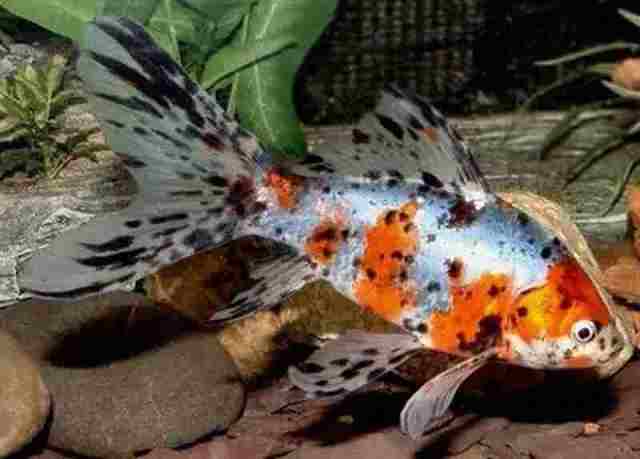Goldfish Care Guide for Beginners and Experts
Introduction
There are two types of hobbyists who keep goldfish. That you have clicked on this article proves that you’re in the serious hobbyist camp.
You have either just purchased or are very close to purchasing a fancy goldfish such as a Ryukin, a Bubble-eye, or maybe even a show-quality Oranda.
However, you’re not too proud to admit that there are some hazy areas in your knowledge base, and you’d like to know more about your new goldfish.
You’re not one of those impulsive people who have zero experience keeping fish and end up getting a goldfish on a whim only to keep it in a small bowl. That poor bowl-fish ends up dead and down the toilet, literally, in a few days.
You feel concern for your aquarium fish and want to do right by them.
Years ago, I too was in a similar situation. I didn’t know everything I should’ve known about caring for fancy goldfish. I still went ahead and kept a bubble-eye goldfish in this 90-gallon tank in my office. I stumbled my way through many mistakes I wish I hadn’t made, but the positive side of my experience is that I learnt from it all.
What I want to do is share all the facts, tips, and tricks I’ve picked up keeping goldfish so that you won’t have to make the same mistakes I made.
Here are a few bits of information I have picked up on my journey so far:
- How large of an aquarium is correct for a goldfish?
- Feeding goldfish.
- What’s the perfect aquarium setup?
- What tank mates can you keep with a Goldfish?
- Common Goldfish diseases, and what to do if your fish gets sick.
- What are the best actions to take to prevent your new fish from ever becoming ill?
Without further ado, let’s get to it.
Oranda
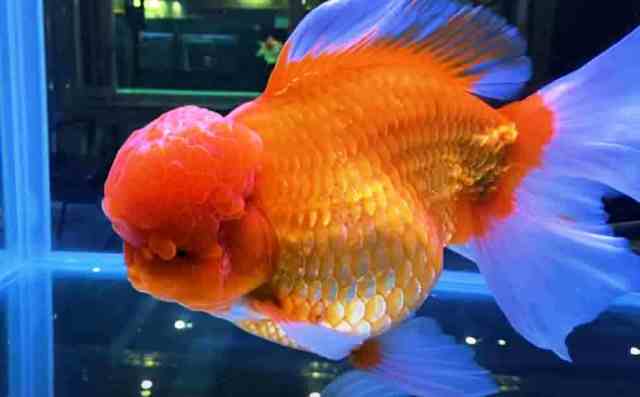
Sumo Body Gold Tiger Oranda – The most expensive goldfish I found on eBay.
An Overview Of Fancy Goldfish
You might already know goldfish aren’t a naturally occurring species. Instead, they were bred from wild carp by humans to be kept as pets.
Goldfish have been around for a long time, with some records suggesting that the first goldfish were bred some 1800 years ago in China.
Over the years, the practice of keeping goldfish as pets, spread to other parts of the world.
They’ve had a storied history, and it wouldn’t be an exaggeration to say that they’ve played an important role in shaping the fishkeeping hobby into what it is today.
You can turn your aquarium fish hobby into an income producing side hustle.
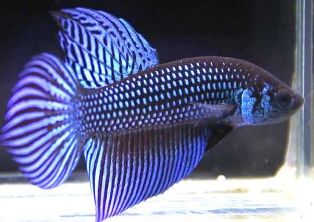
Create a website like mine to earn enough to buy aquariums, or fish, or equipment or if you work hard enough, retire from your 9 to 5.
I used "Divi" website creator to make this website. It costs $89/year (this comes out to about $7/month.)
Tap this ad to find out more.
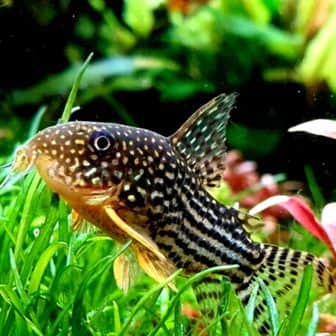
Bubble-eye Goldfish
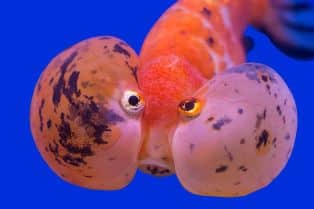
What makes a hybrid Goldfish “Fancy”?
Fancy goldfish result from years of selective breeding aimed at enhancing physical traits of the common goldfish. While the common goldfish is a hardy, streamlined fish with a single tail fin, the fancy varieties exhibit a range of physical attributes. Types of hybridized goldfish include the Veiltail with graceful and the distinctive humped back of the Ryukin. You can also consider the bulbous eyes of the Bubble-eye and the Lionhead with its lion-like mane of flesh
Egg or Eggfish Goldfish (popular in China)
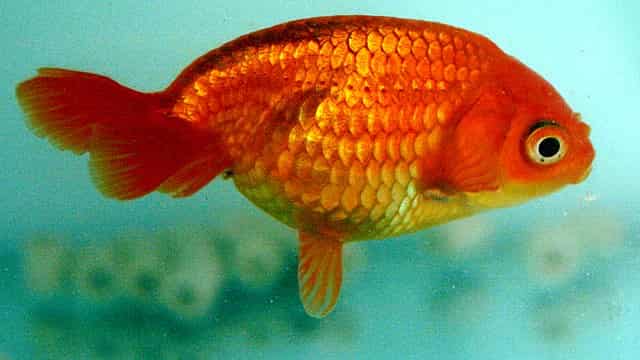
Oscar Fish
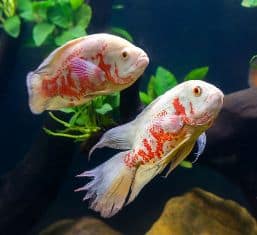
Types of Fancy Goldfish
That brings me to the various types of elegant goldfish. This is not an exhaustive list, but I’ll try to give a brief description of the most popular ones.
-
- Oranda: I’ll start with the elegant Oranda! Their crowning glory is that raspberry-like growth (wen) on their head. Coming in a few color options, they sport a rounded body paired with long, flowy fins that dance with every move.
-
- Ryukin: This fancy goldfish has a unique hump starting right behind its head. Their deep bodies and high dorsal fins set them apart. These are my favorites.
-
- Lionhead: Imagine a goldfish with a mane-like growth. They don’t have a dorsal fin, giving them a sleek, smooth back.
-
- Bubble-eye: Bubble-eye goldfish have large, fluid-filled sacs under their eyes. Handle with care, though; those sacs are superdelicate.
-
- Ranchu: Often dubbed the “king of goldfish,” Ranchus and Lionheads’ are close cousins.
-
- Telescope Eye (or Black Moor): They have eyes that are bred to look up only.
-
- Pearlscale: Their scales are thick and bumpy.
-
- Veiltail: With their long, flowing, and dramatic tail fins, they move with unmatched grace.
-
- Fantail: Fantails have a double tail and slightly less rounded body. They’re among the hardier fancy goldfish and the one I would recommend for those looking to get their first fancy goldfish.

What to look for when buying a fancy goldfish
If you still haven’t splurged on a goldfish, these tips can be very helpful. While any fish you choose needs to be healthy and should have the looks to turn heads, fancy goldfish need a bit more attention to the finer details. Here is how I’d approach it.
Observe the Fish’s Behavior:
- Activity Levels: A healthy goldfish should be active and swim with purpose. Beware of fish that remain stationary at the bottom of the tank or those that seem to struggle to maintain their balance.
- Interaction: Watch how the goldfish interacts with its tank mates. While some level of territorial behavior can be normal, excessive aggression or extreme timidity can be concerning.
Examine The Physical Appearance:
- Clear Eyes: The eyes should be clear and bright. Cloudiness, swelling, or protrusion can be signs of potential health issues.
- Body Condition: The fish’s body should be plump and well-rounded with no visible injuries, ulcers, or patches of missing scales.
- Fins: The fins should be intact, fully extended, and free of tears or clumps. Clamped fins can indicate stress or illness.
- Color and Patterns: While color can vary based on genetics and age, a vibrant, even coloration is a good sign. Pale or faded colors might point to stress or poor health.
Environment Matters:
- Tank Cleanliness if buying in a pet store: A clean tank indicates good maintenance, which is crucial for the well-being of the fish.
- Tankmates: Look at the other fish in the tank. If they appear healthy, it’s a good sign. If multiple fish show signs of illness, it might be best to look elsewhere.
Ask Questions:
- Origin: Ask the seller about the origin of the fish. Knowing whether it’s locally bred or imported can give insights into its adaptability and potential health concerns.
- Diet: Find out what they have fed the fish. This will help you continue with a similar diet or gradually transition to a new one.
- Recent Health History: Inquire if the fish has recently been treated for any diseases or if there have been any disease outbreaks in their tanks.
Trust Your Instincts:
- Even if everything seems perfect on paper, trust your gut feeling. If something feels off or you’re unsure, it’s okay to take a step back and reconsider.
Fancy Goldfish Care: Quick-Start Guide
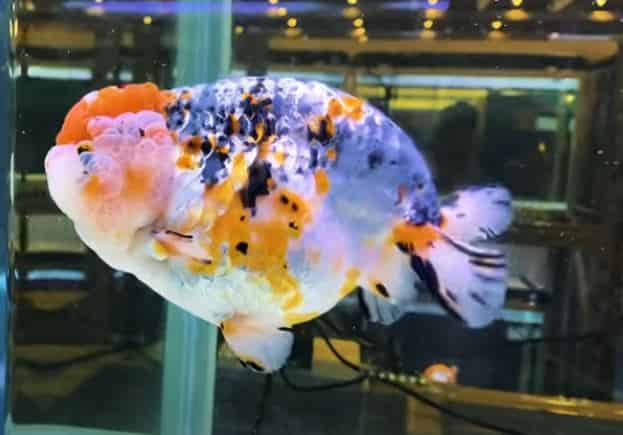
How big do fancy goldfish get?
The fat body type will get 5 to 7 inches long. More…
How long will a fancy goldfish live? (Lifespan)
Goldfish, including hybrid/fancy types, can live 15 to 20 and even up to 30 years when well care for. More…
Are fancy goldfish easy or difficult to care for?
Medium. Caring for a big fish means a lot of waste. Keeping the tank clean is a key to goldfish care.
What size aquarium do fancy goldfish require?
I’m going to go against the majority of fish keepers online and say 60 to 75 gallon aquarium for one fancy or 90 to 100 gallons for two fancies. If you want tank mates bump that up to 120 gallons to be safe and reasonably understocked. More…
How many fancy Goldfish can I put in my aquarium?
One in a 55 gallon tank. Two in a 75 to 90 gallon tank.
This is my recommendation based on being a firm believer in understocking an aquarium and these are big, fat fish.
What water conditions do fancy goldfish need?
1. Unheated basement aquarium would be the first choice.
2. They are not picky about pH or water hardness. Tap water with a good quality aquarium water conditioner should work fine.
3. Slow moving water in a tank that is over-filtered.
What other fish can I keep with my golfish?
Goldfish need cool water to be healthy so this limits the fish you can keep with them to other cool water tolerant fish. These include Chinese Mountain Steam Loaches, Zebra Danios, White Cloud Minnows and other Goldfish.
What should I feed my fancy goldfish? How much? How often?
Good question. What to feed: a good quality processed fish food that is low in grains is suggested (always check the ingredients. Live or frozen live foods are even better. Vegetables (spinach, broccili, squash, etc.) are a must.
In regards to how much and how often, I am going to go with a scientfic study I found and say that feeding your fish twice per day with all they can eat in 5 to 15 minutes. The study saw the fastest growth of the goldfish in the study were the ones feed twice a day vs fewer or more feedings. https://www.researchgate.net/publication/279236515_Influence_of_Feeding_Frequency_on_Growth_performance_and_Body_Indices_of_Goldfish_Carrassius_auratus
Are fancy goldfish peaceful or agressive?
Peaceful. Fancy goldfish are a gentle fish.
How much do fancy goldfish cost?
If you buy a fancy goldfish from a bigbox pet store you will pay about $35. You might want to buy two because about 30% of all big box store fish die in the first couple of weeks.
If you buy from a local fish store you will probably pay $50 to $70.
If you buy from eBay you will spend $70 for a non-descript fancy. If you want a high quality fancy gold fish you will need to spend $100 and up when shipping is included.
You’re going to have your fancy goldfish for a long time so, were it me, I would go on eBay prepared to spend up to $250+ for a super high quality fish.

Are fancy goldfish easy or difficult to breed?
Very Easy. A well cared for pair of Goldfish will breed without any additional help from the hobbyist.
Do Fancy Goldfish need a planted aquarium?
No, they don’t care what’s in the tank. I would go with a bare bottom tank based on how much poop they produce. Check out this picture a goldfish w/ poop:
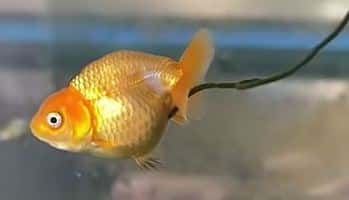
Telescope Eye Goldfish
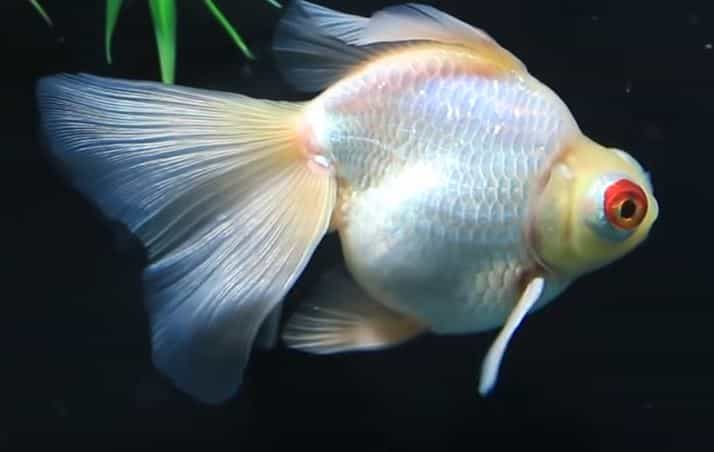
How big to these fish get? (Types and Size)
Most fancy goldfish varieties attain an adult size ranging between 6 to 8 inches.
Fancy goldfish grow quickly during their initial years. On average, they can grow up to 1 to 2 inches annually for the first few years. That’s why it is very important to make sure that the tank can accommodate their adult size. If you really must start with a smaller tank, then have a solid plan of eventually upgrading to a larger one. However, I’ve learnt from experience that starting with the correct size tank is always better than going through the hassle of re-homing fish.
That brings me to their maximum size. A combination of factors influences the eventual size of a fancy goldfish. Primarily, the specific variety of the goldfish plays a pivotal role.
Another crucial factor that affects their growth is the tank conditions. A well-maintained tank with optimal water parameters, adequate space, and a balanced diet can significantly promote growth. Think about it: if you’re living in a spacious, clean place with plenty of good food, you’d probably be happier and healthier. Same goes for the fancy goldfish. A big, well-kept tank with all the right equipment can make a world of difference for their growth.
Conversely, a cramped or poorly maintained environment will have the opposite effect.
Here is a list of the most common fancy goldfish and their maximum size, to help you get an idea of what you are getting yourself into.
- Ryukin Goldfish: 8-10 inches
- Oranda Goldfish: 7-9 inches
- Black Moor Goldfish: 6-8 inches
- Pearlscale Goldfish: 5-6 inches
- Bubble Eye Goldfish: 6-8 inches
- Ranchu Goldfish: 6-8 inches
- Lionhead Goldfish: 5-6 inches
- Celestial Eye Goldfish: 5-6 inches
Fantail Goldfish
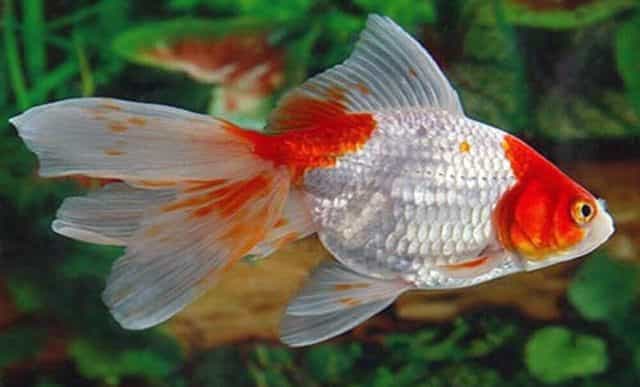
The Lifespan of Fancy Goldfish: What Determines Their Longevity?
From personal experience, I can confirm that when given the right care, fancy goldfish can live quite long. They can often reach 10-15 or more years. But what’s the secret behind long living goldfish? Let’s break it down!
- Cool Waters: This is a mistake I’ve seen even a lot of seasoned pros make. They treat goldfish as tropical fish. All goldfish, including the fancy ones, prefer cool temperatures. While they can handle a range of temperatures, they truly thrive in cooler waters. It keeps their metabolism in check and can contribute to their long lifespan. The ideal water temperature for them is between 65 and 72°F or (18 to 22°C). I have seen goldfish in an outdoor pond I had, survive when the water was a little above freezing.
- Good food: A varied and balanced diet is essential. It keeps them happy, healthy.
- Great living conditions: Regular water changes and a good filtration system are the backbone around which the long lifespan of a healthy goldfish is built.
- Good Genes: Just like humans, a goldfish’s family tree matters. If their lineages were healthy, chances are they’ll have a good long run too. This is why you should always get your fancy goldfish from reputable breeders or shops.
Goldfish Behavior
Fancy goldfish aren’t too different from their more common cousins as far as behavior is concerned. These fish are social and thrive in the company of their own kind. They’re known for their playful nature, frequently seen chasing each other or engaging in mock battles. This activity is typically harmless. They’re happiest when they are around other goldfish.
They are also inquisitive creatures, showing keen interest in their surroundings. They’ll often explore plants, decorations, and even interact with their human caregivers.
Because of their exaggerated body shapes, they may not be as swift or agile as their common goldfish counterparts. It’s not uncommon to see them glide gracefully rather than dart rapidly in the aquarium. This is where special care must be taken with tank setup.
- The tank should be large enough – A cramped tank can lead to stress and stunted growth.
- There should be plenty of open space.
- The water flow inside the tank should be gentle. Their exaggerated body features may look good, but they aren’t very functional. If there is strong water flow in the tank, these fish will tire themselves out just trying to stay upright.
- Keep the decorations sparse and avoid anything with sharp or jagged edges – These fish aren’t very good at navigating around obstacles.
Freshwater shrimp
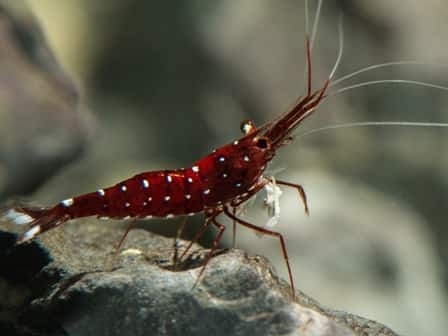
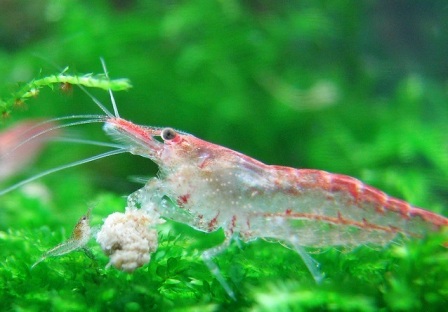
Discus
Discus Care
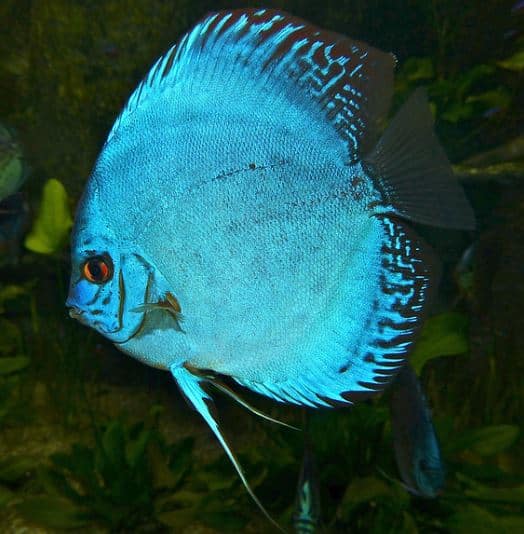
What to feed your fancy goldfish, how much and how often
They will eat just about anything edible that you throw in their tank. Because of the shape of many of the hybrid styles (call them round for a lack of a better description) it’s an excellent idea to go heavy with cooked veggies. For example: peas, lima beans, spinach, collard greens, squash, beets, and cabbage.
Of course, you will want to feed them protein based foods like processed fish food, frozen and flash frozen like brine shrimp, bloodworms, etc.
Homemade fish foods based on liver, shrimp, or beef hearts are also a good choice.
Tried and true is the way to go when wondering how much and how often to feed your fancy. Feed them as much as they can eat in 5 to 15 minutes (the amount of time depends on the type on how easy or difficult it is to find the food). In researching feeding for Goldfish I came across the following study about goldfish feeding. It showed that feeding young goldfish twice a day (vs. less or more often) led to the fastest growth. https://www.researchgate.net/publication/279236515_Influence_of_Feeding_Frequency_on_Growth_performance_and_Body_Indices_of_Goldfish_Carrassius_auratus
Type: Tosakin – fat body, long or large fins
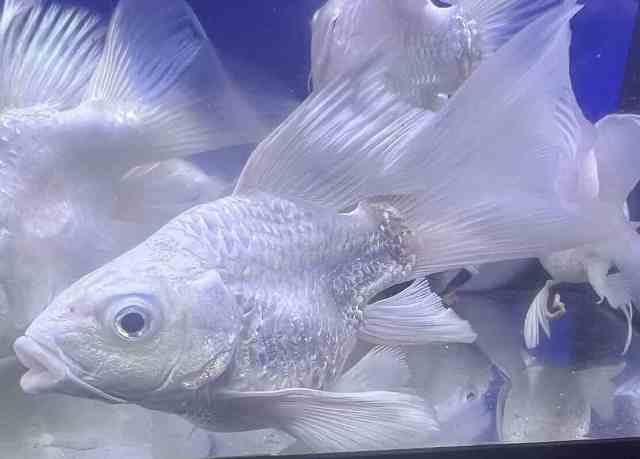
The Correct Tank and Water Conditions for Fancy Goldfish
Everything I’ve mentioned so far might make it seem as if fancy goldfish are the perfect fish. However, you need to get a few things just right to end up as one of the success stories.
Tank Size
A spacious tank allows them to swim freely, grow to their full potential, and stay active. For a single fancy goldfish, start with a tank of at least 60 gallons. For every additional goldfish add another 40 gallons of tank space. This suggestion for tank space is from my experience. Remember, these aren’t “bowl fish”; they need plenty of room to flourish. A larger tank also helps maintain stable water conditions, which are critical for their well-being.
Water Parameters Needed to Keep Them Healthy
Fancy goldfish thrive in specific water conditions. Maintain a pH level around 7.0. Ensure zero ammonia and nitrite levels, while keeping nitrate levels low. Water temperature should be consistent, ideally between 65 to 74°F (18 to 22°C). Helpful hint: If you run a fan blowing over the top of the tank water, it will help cool the temperatures down to where the goldfish prefer.
Regularly test the water for these parameters.
What type of filtration is suggested?
Goldfish produce a significant amount of waste. A high-quality filter is a “must-have”. Opt for filters with strong mechanical, chemical, and biological filtration capabilities. Canister filters or hang-on-back filters are good choices for goldfish tanks. They efficiently remove waste, uneaten food, and toxins, ensuring the water remains clean and oxygen-rich. Choose a filter that is rated to filter at least twice the volume of water in your tank every hour.
The substrate
I have seen fancy goldfish kept in bare bottom tanks with no substrate. While this can make cleaning easier, it also reduces the surface area available for beneficial bacteria. I prefer a tank with a substrate. Smooth, rounded gravel is the way to go, I think.
What Conditions Would Be Considered Paradise?
For a fancy goldfish, paradise is a spacious, clean tank with well-oxygenated, cool water. I would adorn the aquarium with smooth substrate and live, goldfish-friendly plants. Throw in some gentle water currents, a few hideouts, a consistent light cycle, a balanced diet, and compatible tankmates, and you’ve got goldfish heaven.
How To Maintain Your Goldfish Aquarium
This is where proper tank maintenance comes in. Just as you and I wouldn’t enjoy living in a dirty home, Goldfish thrive best in clean, well-maintained environments.
Regular maintenance reduces harmful toxins, prevents the growth of dangerous bacteria and parasites. This ensures that your fish have the best possible quality of life.
Steps to Ensure a Pristine Goldfish Haven:
- Regular Water Changes: This can’t be emphasized enough. All goldfish produce a lot of waste and over time, waste accumulates in the water to dangerous levels. Changing about 10 to 90% of the tank water weekly can combat this.
- Gravel Cleaning: Using a gravel vacuum during water changes helps remove fish waste, uneaten food, and other debris. This not only keeps the substrate looking clean, it also prevents harmful ammonia and nitrite spikes.
- Filter Maintenance: Filters trap debris and house beneficial bacteria that break down toxins. Cleaning the filter media in tank water (never tap water!) every few weeks ensures it functions efficiently.
- Monitor Water Parameters: Using water test kits, regularly check the levels of ammonia, nitrites, nitrates, and pH. Keeping these parameters in check is crucial for Goldfish health. This said, if you care for the filter media (beneficial bacteria) and do massive water changes weekly, you won’t need to worry about these items.
- Observe Your Fish: It never hurts to sit in front of your aquarium for a few minutes each week. If you do this you will probably see things that you wouldn’t have noticed otherwise. Always be on the lookout for changes in your goldfish’s behavior or appearance. Early detection of health issues can be a lifesaver.
Should You Decorate The Aquarium Or Would Aquascaping Look Better?
Decorate
Decorating an aquarium means you can add just about anything. For example, if you’re a hobby newbie, you could add a large sunken ceramic ship, bubbler lights, or a few colored marbles.
Of course, goldfish aren’t picky about the tank decor. However, here are some guidelines to make it a great experience for both you and the fish.
Your Goldfish Should Be The Center Of Attraction When Decorating The Tank
It is very easy to go overboard and fill the tank with every knick-knack you can find in an aquarium store. Less really is more. The fish need to be the primary focus. A minimalistic approach is the best way to go.
Space is Gold
These big fish need lots of room to swim. Keep the center of the tank relatively open, allowing the fish to glide gracefully without obstructions.
Aquascaping A Goldfish Tank
Aquascaping an aquarium means creating a natural-looking aquarium setup
Plants
If you plan on trying out plants in your goldfish tank, you will need a substrate to hold the plants in place. A two to four-inch layer of smooth, rounded gravel is your best bet. Not just because it looks good, but because the curious goldfish love to sift through it, and you don’t want any injuries.
Normally goldfish and plants do not go together too well. Uprooted plants are the usual outcome. Also, the cooler water temperatures might reduce the plant options you have to choose from. With a bit of planning, you can keep fancy goldfish in an aquascaped tank. In fact, my favorite tank style is an aquascaped one.
Goldfish are notorious plant nibblers and so you will have to choose hardy plants like Anubias or Java fern. These plants are resilient and less likely to be chewed on and they can withstand the cooler temperatures that these fish need. The plants don’t need strong lighting, which is another plus, as the fish won’t get spooked or appear washed out from having too much light in the aquarium.
Rocks and Driftwood
These natural elements can create nooks and crannies for your goldfish to explore. Go for smooth stones and well-soaked driftwood with smoothed edges to ensure your fish are safe.
Before buying or setting anything up, it might be a good idea to create a vision on paper or your computer to visualize where everything should go.
Once again, the minimalistic approach works best. Use décor sparsely to complement the fish.
Common Goldfish Diseases and Cures
Goldfish are quite hardy, but all the selective breeding that goes into creating fancy goldfish does come with a few downsides. One of them is the fact that fancy goldfish are more prone to certain health issues.
Prevention Vs. Cure
While it’s essential to know the treatments for these diseases, prevention is always a better strategy. A clean tank, proper filtration, regular water changes, and a balanced diet can prevent most common goldfish diseases. Stress is a significant factor that can make fish susceptible to illnesses.
By avoiding diseases in the first place, you save yourself the heartache and hassle of treating sick fish. You also ensure a happier, healthier life for your aquatic pets. A little preventative care can go a long way in keeping your goldfish disease-free!
Disease: Ich (White Spot Disease)
Symptoms
Tiny white spots on fins and body, fish rubbing against objects.
Treatment
Increase water temperature slightly for a short period, use specialized Ich treatments available at pet stores.
Image: Ich (white spots on fins)
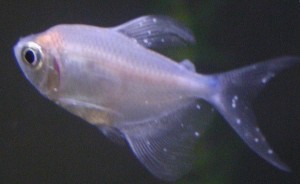
Disease: Dropsey
Symptoms
Bloating, scales sticking out (making fish look like a pinecone).
Treatment
This is often a sign of internal bacterial infection. Antibiotics might help, but prognosis is often poor.
Image: Dropsey

Fin Rot
Symptoms
Fraying, disintegrating, or discolored fins, sometimes white edges.
Treatment
Improve water quality, apply antibacterial fish treatments.
Image: Fin Rot
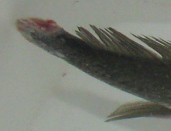
Fungus
Symptoms
Cotton-like growths on skin, loss of appetite.
Treatment
Anti-fungal medications, improve water quality.
Image: Fungus

Swim Bladder Disease
Symptoms
Fish has difficulty swimming, might float upside down or on its side.
Treatment
Feed a high-fiber diet, like peas, and consider fasting the fish for a day or two.
Image: Swim Bladder Disease
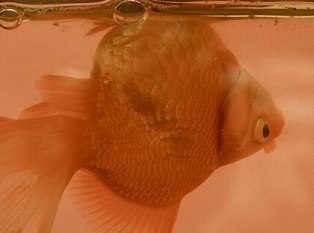
By Humanfeather / Michelle Jo – Own work, CC BY 3.0, https://commons.wikimedia.org/w/index.php?curid=10174720
How expensive are “specimen” show-quality goldfish?
Aquarium goldfish can be very expensive. The breed, the quality of the fish, and the proportion of the fins and colors, will set the market value of the aquarium animal. Goldfish of different types, with good bloodlines and excellent colors, fins, eyes and body shape, can reach thousands of dollars when auctioned. The most expensive Goldfish on record are of the Oranda varieties.
What’s the most expensive goldfish ever sold? I’ve seen lots of claims but no solid evidence. That is something you will need to research on your own and decide for yourself.
Looking on eBay, I saw goldfish types for sale from $50, to $200 and even up to thousands of dollars.
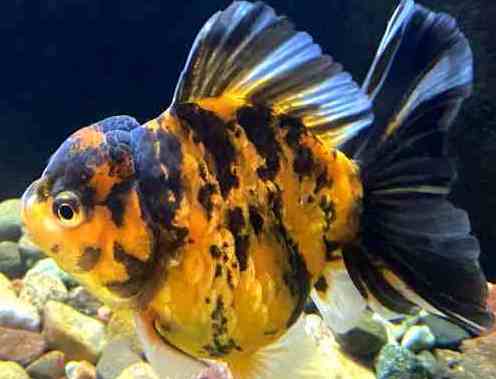
Tap image to view full size – Sumo Body Gold Tiger Oranda – The most expensive goldfish I found on eBay.
Infographic Below: Cool water Goldfish Tankmates
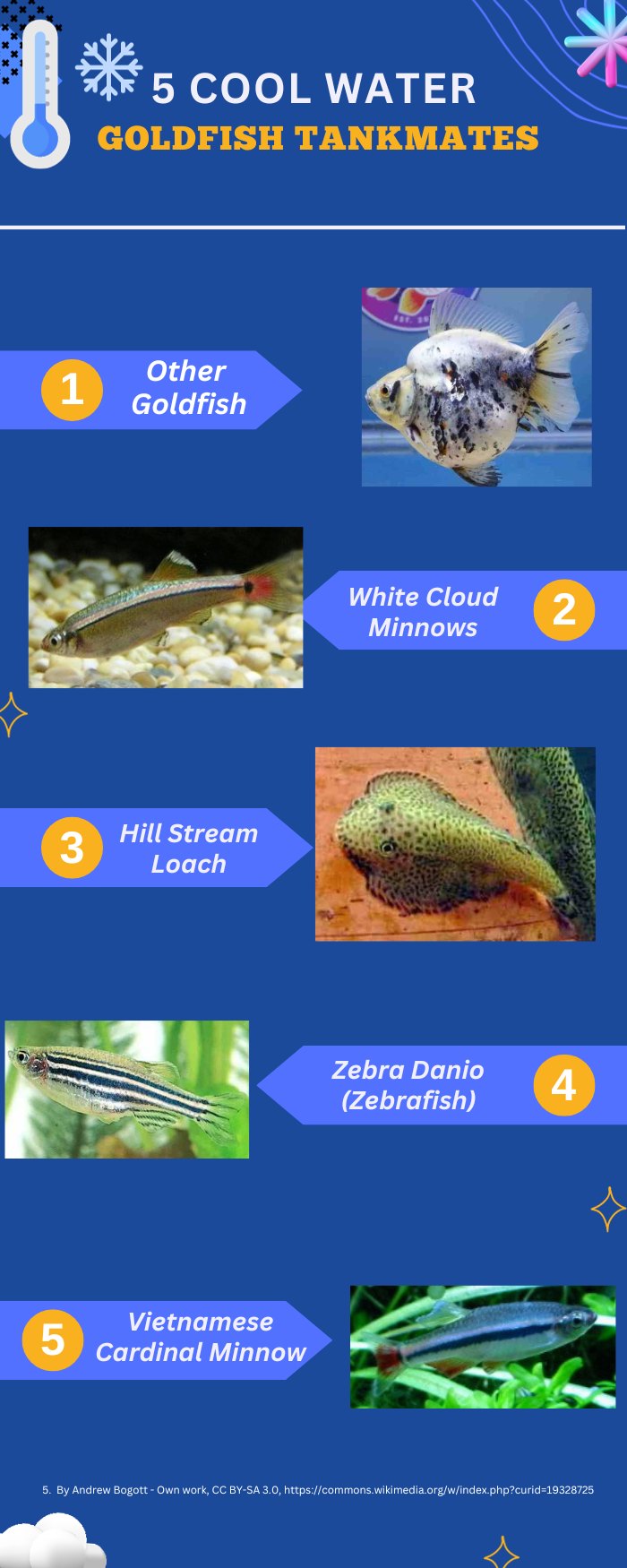
Goldfish Reproduction By The Numbers – Breeding Fancy Goldfish
12 steps and ideas for successfully breeding goldfish.
https://aquatechnidocwestly.weebly.com/uploads/1/0/6/3/10636182/breeding_of_goldfish.pdf
https://www.researchgate.net/publication/345432502_Breeding_of_Goldfish
1. Spawning stock goldfish will need to be at least 8 to 15 months old.
2. Male and female goldfish sex characteristics:
a. Female goldfish have rounder bodies (it may be difficult to tell in hybrid goldfish). The female genital opening will be rounded outwards and will be larger than the male.
b. Male gold fish have a longer body (it may be difficult to tell in hybrid goldfish). Another sex indicator of male goldfish is that tubercles (white bumps) will appear on the head, pectoral fins and other fins. The male genital opening is concave and smaller than the females.
3. Outdoors, natural spawning is continuous during warm months and will stop during winter.
4. Healthy, well-fed goldfish can / will spawn every 15 to 20 days. This will happen automatically without outside help from the hobbyist.
5. When the females are ready to lay eggs, the male goldfish will follow her around very closely. Female goldfish produce pheromones that let the male know she is ready to spawn.
6. Goldfish females can lay up to 1000 eggs per spawning.
7. The hobbyist may strip the eggs and sperm by hand from the male and female goldfish if desired.
8. In an aquarium, there are a couple of ways to proceed when breeding:
a. Use a spawning mat. A spawning mat is made to fit the size of the aquarium. The mat is often made of yarn, string or plastic strips.
The female will aggressively push into the mat and release her eggs, followed by the male, who then fertilizes the released eggs.
After spawning, either the eggs or the adult goldfish will need to be moved to a different aquarium because the adults will eat the eggs if given a chance.
b. Use spawning trays. Spawning can also occur in a tank with spawning trays (plastic trays) with slits in them for the eggs to fall through, protecting them from the adults.
9. After moving either the adults or the eggs to a different tank, gently aerate the aquarium that the eggs are in.
10. Under proper conditions, approximately 90% of the eggs will hatch about 5 days after spawning.
11. After hatching, the fry will have about two days where they’re nourished by their yolk. After the yolk is gone, they will begin swimming and the breeder can begin feeding foods small enough for the fry to fit in their mouths.
12. When the brood is 8 to 15 months old, they will be ready to spawn and continue the cycle.
Type: Veiltail Goldfish
Long, flowing fins
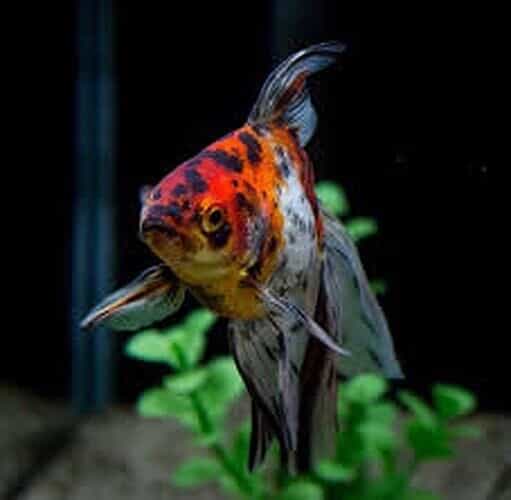
Type: Oranda Goldfish
Short, stubby with fleshy growth on top of their heads called a “wen”.
Although they look somewhat similar to a lion head gold fish they differ in that they have the wen only on the top of their heads. The lionhead will have the wen all the way around the head.
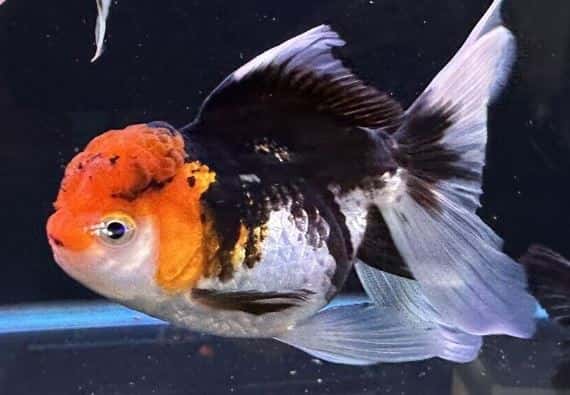
Did I Miss Anything?
If you still have questions about fancy goldfish care you can email me your questions: donglasgow @ outlook.com (delete the spaces).
The Best Freshwater Aquarium Fish for Beginners 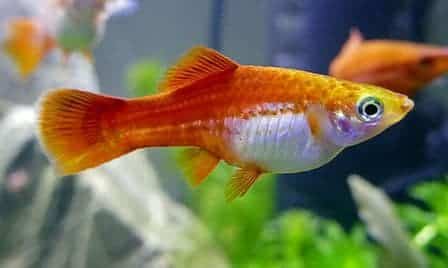
You can do the math; population control is a must. The bad news is that guppies rarely eat their offspring. You will want a predator fish, like an angelfish, in with your guppies to keep the numbers down.
Signs of ammonia in your aquarium fish tank
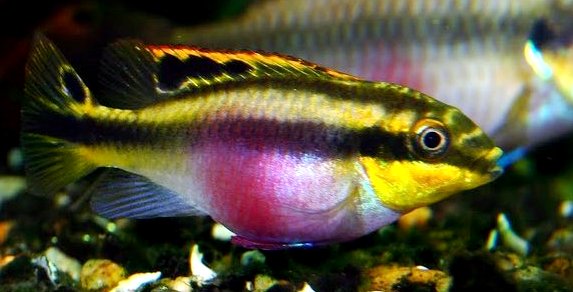
“This might be a good luck / bad luck article. I suspect that if you’re reading this; you have an ammonia problem in your aquarium already (bad luck). That said, I’ll help you as much as I can for your sake and the sake of your fish (good luck).”
